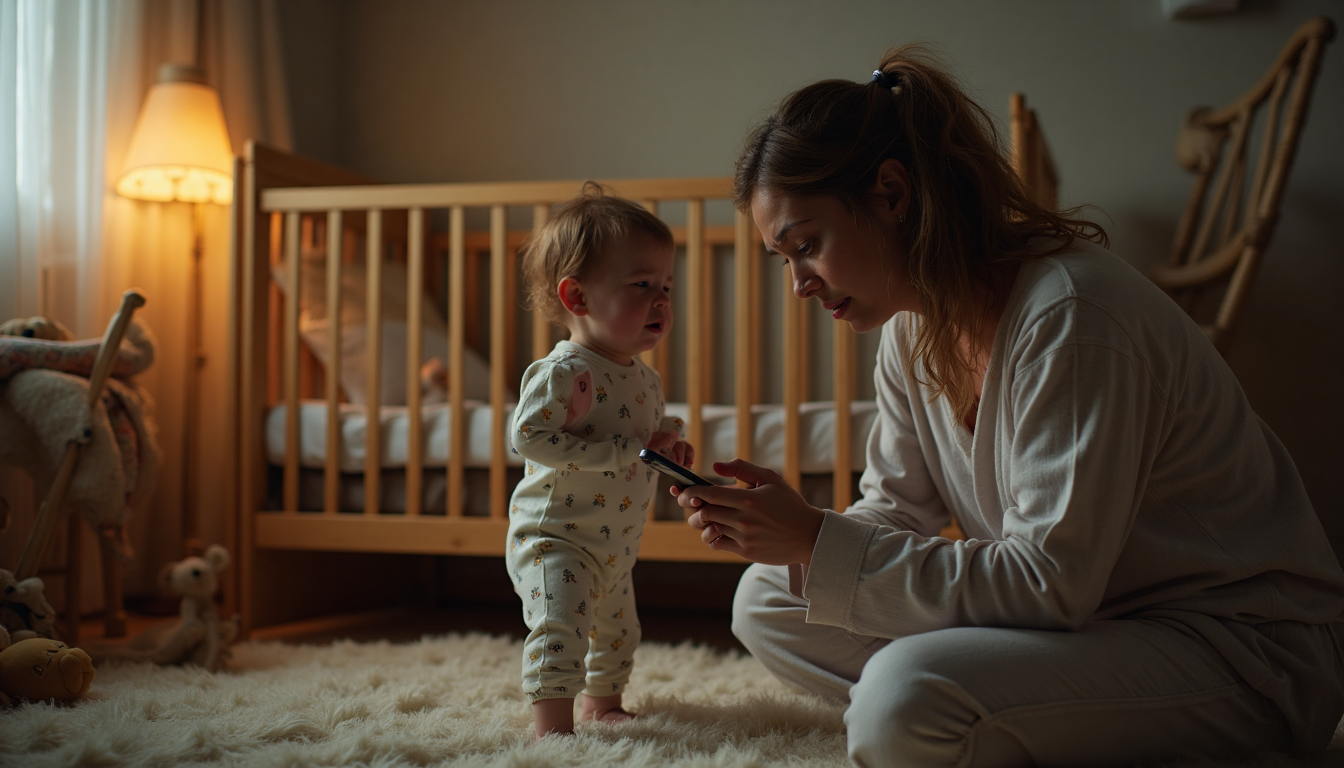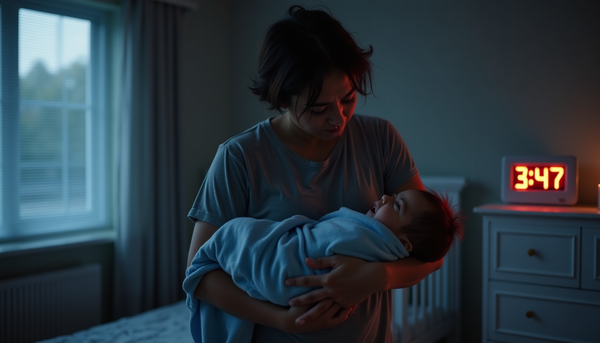Sleep Training Your 1-Year-Old Without Losing Your Sanity

Sleep Training Your 1-Year-Old Without Losing Your Sanity
Let me start with a confession: when my daughter turned one, I was still rocking her to sleep for 45 minutes every night, then tiptoeing out of her room like I was defusing a bomb. One creak of that damn floorboard and BOOM – we'd start all over again.
Sound familiar? Yeah, I thought so.
Here's the thing about sleep training a 1-year-old that nobody really tells you upfront – it's completely different from sleep training a younger baby, but somehow everyone acts like you should just apply the same methods and hope for the best. Spoiler alert: that doesn't usually work out so well.
Why 1-Year-Olds Are Sleep Training's Final Boss Level
By their first birthday, toddlers have developed some... let's call them "strong opinions" about how things should go. They're smart enough to remember what worked yesterday (crying until mom came back) but not quite mature enough to understand why that's not happening tonight. It's like negotiating with a tiny, irrational CEO who runs entirely on emotion and Goldfish crackers.
Plus, they're dealing with a perfect storm of developmental stuff:
- Separation anxiety that makes them think you've vanished forever the moment you leave
- Newfound independence that makes them want to test every single boundary
- Physical milestones like walking that make their brains too excited to sleep
- Nap transitions because apparently one major sleep change isn't enough
Fun times, right?
The Truth About Sleep Training Methods (That Actually Work)
I've tried pretty much every method out there, and here's my honest take on what works for this age group – spoiler: it's probably not what you think.
The Gentle Approaches That Don't Make You Feel Like a Monster
The Sleep Lady Shuffle (my personal favorite failure-turned-success story) This one's basically where you start sitting next to their crib, then gradually move your chair further away every few nights until you're outside their room. My daughter treated this like a game at first – she'd hang over the crib rail trying to touch my hair while I pretended to be invisible. But honestly? After about a week of consistency (and me learning to sit just out of arm's reach), it clicked.
The Chair Method Similar concept, but you're more of a silent presence. The trick here is resisting the urge to talk or pat them every time they fuss. I made this mistake for three nights straight before realizing I was basically providing entertainment, not comfort.
The Methods That Sound Good But Usually Backfire
Pick Up/Put Down This one sounds so logical, right? Kid cries, you pick them up until they calm down, then put them back. Repeat as needed. What they don't tell you is that some toddlers will turn this into a fun game where they fake-cry just to get picked up. My son figured this out in exactly one night. Too smart for his own good.
Traditional Cry-It-Out Look, I'm not going to shame anyone who chose this route, but with 1-year-olds, it often just turns into a battle of wills that nobody wins. These kids have stamina and determination that would impress military trainers.
The Framework That Actually Works (Most of the Time)
After two kids and way too much trial and error, here's what I've learned actually matters:
Step 1: Fix the Timing First
This is where most people mess up (myself included). You can have the perfect bedtime routine, but if your timing is off, you're fighting an uphill battle.
Wake windows are your secret weapon here. At 12 months, most toddlers can handle about 3-4 hours awake before they hit the overtired danger zone. But here's the catch – every kid is different, and you need to watch YOUR kid's signals, not just follow the internet's schedule.
My daughter could push 4.5 hours easy, while my son started melting down at 3 hours on the dot. Figure out your kid's sweet spot and protect it like it's precious (because it is).
Step 2: Create a Routine That's Actually Sustainable
Everyone talks about bedtime routines, but they usually suggest these elaborate 45-minute productions that work great... until life happens and you need to get your kid to bed in 15 minutes because dinner ran late.
Keep it simple:
- Something calming (bath, book, whatever)
- Something connecting (cuddles, singing, talking about the day)
- Something final that signals "this is it" (into the crib, lights out, door closing)
The key is making it short enough that you can actually stick to it every single night, even when you're exhausted or running behind.
Step 3: Master the "Drowsy but Awake" Thing
This phrase gets thrown around a lot, but what does it actually mean? I used to think it meant barely conscious, which led to a lot of babies who were either too alert or who fell asleep the second they hit the mattress.
The sweet spot is calm and relaxed, but with their eyes still open and aware of where they are. Think of it like that feeling when you're reading in bed and starting to get sleepy, but you're still following the story.
Age-Specific Challenges (And How to Handle Them)
12-13 Months: The Separation Anxiety Peak
This is when your previously chill baby suddenly acts like you're abandoning them forever every time you leave the room. It's exhausting and heartbreaking, but it's also totally normal.
The trick here is consistency without being cold. Use your voice more than your presence – talk to them from outside the room so they know you're still there, but don't keep going back in unless something is actually wrong.
14-15 Months: The Boundary Testing Olympics
Welcome to the phase where your toddler discovers they can stand up in their crib and just... not lie back down. They'll stand there like a tiny protester, sometimes for hours, just to see what you'll do about it.
Here's what worked for me: one calm instruction to lie down, then ignore the standing. Don't make it into a game by constantly telling them to lie down. They'll figure out eventually that standing up is way less comfortable than lying down.
15-16 Months: The Great Escape Artists
Some kids start climbing out of their cribs around this age, which Obviously complicates sleep training. If this happens, lower the mattress to the lowest setting first. If climbing continues, you might need to transition to a toddler bed sooner than planned, which means sleep training becomes room training.
The Mistakes I Made (So You Don't Have To)
Mistake #1: Giving up too soon I thought if it didn't work in 3 nights, the method was wrong. Truth is, most approaches take 7-10 nights to really stick, and there will be setbacks. Teething, growth spurts, daylight saving time – everything throws off sleep temporarily.
Mistake #2: Being inconsistent between parents My husband and I had different approaches for the first few weeks, which just confused our daughter and made everything take longer. Get on the same page BEFORE you start.
Mistake #3: Overthinking the crying Some crying is inevitable, and that's okay. I spent so much energy trying to prevent any tears that I actually made the process longer and more confusing for my kids.
Mistake #4: Ignoring wake windows I thought bedtime was bedtime, regardless of naps. Wrong. A kid who's been awake for 6 hours is going to be a disaster, no matter how perfect your routine is.
What to Expect (Realistically)
Most kids show significant improvement within a week to 10 days, but "improvement" might mean sleeping through 50% of nights instead of 0%. Don't expect perfection immediately.
You'll probably have:
- 2-3 really rough nights at the beginning
- Some random setbacks just when you think you've got it figured out
- At least one night where you question everything and consider going back to your old ways
- Gradual but noticeable progress over 1-2 weeks
When to Throw in the Towel (Temporarily)
Sometimes it's just not the right time, and that's okay too. If your kid is sick, you're dealing with major life changes, or you're just not in the right headspace to be consistent, it's better to wait a few weeks than to start and stop repeatedly.
I put off sleep training my son for two months because we moved houses right before his first birthday. Was I exhausted? Absolutely. But trying to establish new sleep habits while everything else in his world was changing would have been setting us both up for failure.
The Bottom Line
Sleep training a 1-year-old isn't about finding the perfect method – it's about finding the method that works for YOUR kid and YOUR family, then sticking with it long enough to see results.
Your toddler is going to test boundaries. They're going to have setbacks. You're going to second-guess yourself. This is all completely normal and doesn't mean you're doing anything wrong.
The goal isn't perfect sleep immediately – it's building skills and habits that will serve your whole family well in the long run. And honestly? Even if you just get to the point where bedtime doesn't feel like going to war every night, that's a huge win.
Trust yourself, trust the process, and remember that sleep training isn't permanent. These skills will stick, but if something stops working, you can always adjust your approach.
How's your sleep training journey going? Are you in the thick of it right now, or still working up the courage to start? Either way, you've got this – even when it doesn't feel like it.




